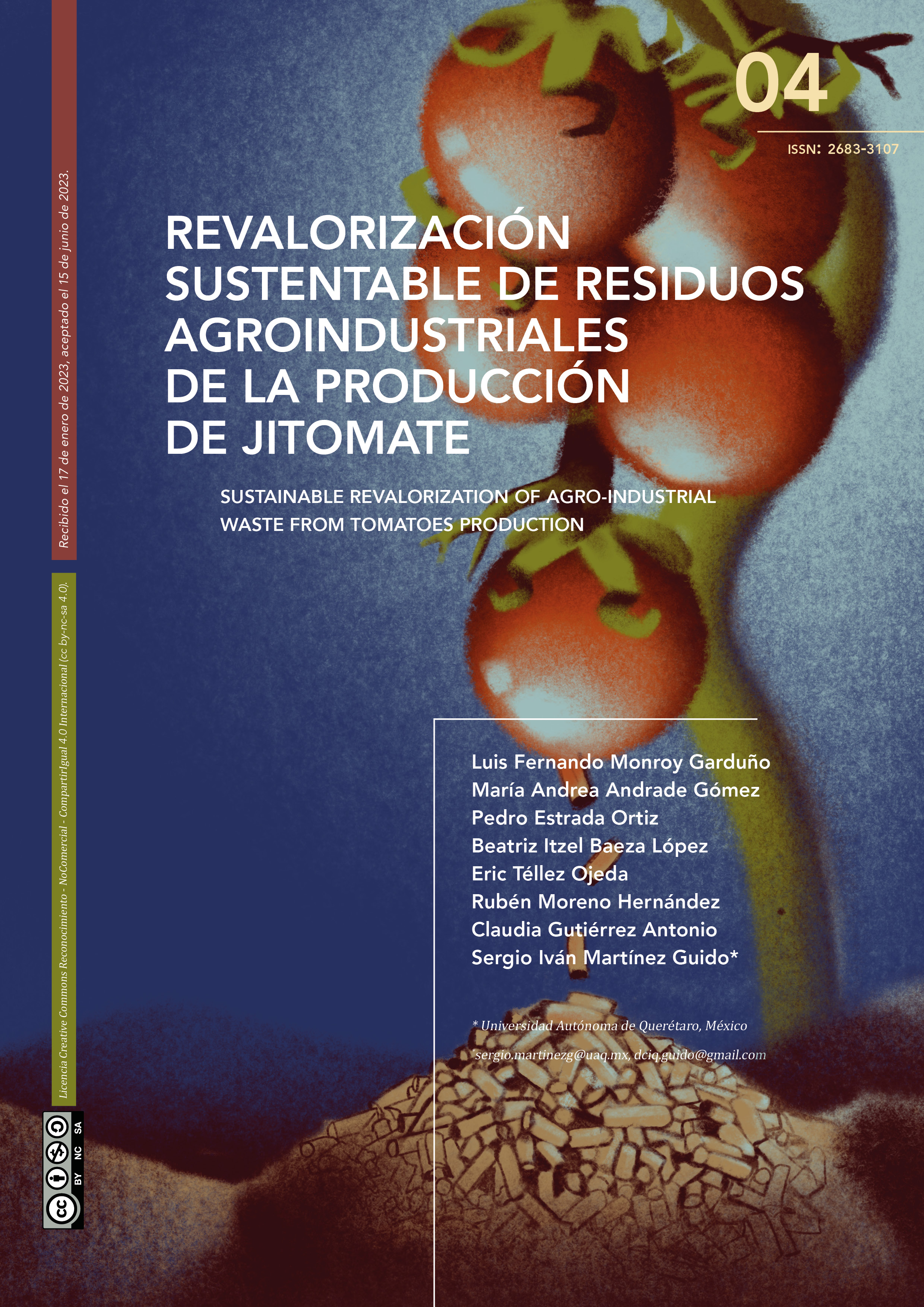Abstract
Nowadays, agricultural waste has become a global problem because there is no strategy for its management; thus, most of them ends up in landfills, and in the worst of cases burned, wasting their potential. In particular, Mexico is the world’s leading tomato supplier, contributing 3.46% of gross domestic product. Such production also involves the generation of large volumes of waste. In this context, the present paper proposes producing solid biofuels (pellets) from organic agricultural waste generated in tomato production to be integrated into the production chain as an alternative energy source in the greenhouse, evaluating economic and environmental aspects. Pellets are integrated into the production system as a heat source in greenhouses replacing LP gas. As a case study, tomato production was considered; from which the amount of residual biomass generated was taken as the basis to produce fuel pellets, climatic conditions, and the energy potential for use as biofuel were taken as the basis to produce fuel pellets. The results show that the waste generated in tomato production can supply more than 77% of the energy required for heating the greenhouse. It is developing an economic saving of more than USD 918 and reducing by 87% the environmental impact per productive period, compared to the expenditure of gas LP. In this way, it is possible to observe that the reintegration of waste generated by tomato production as a source of green energy is a promising strategy for developing biofuels that reduce dependence on fossil fuels. Likewise, the return of such waste is one activity that contributes to transit to the circular economy by taking advantage of the by-products generated.
References
Organización de las Naciones Unidas para la Alimentación y Agricultura FAO. (2022) Alimentación y agricultura sostenibles. [Online]. Available on: https://www.fao.org/sustainability/background/es/
G. Forkuor, W. Amponsah, P. Oteng-Darko, G. Osei, “Safeguarding food security through large-scale adoption of agricultural production technologies: The case of greenhouse farming in Ghana”, Cleaner Engineering and Technology, vol. 6, pp 100384, 2022, 10.1016/j.clet.2021.100384
I. Tsafaras, J.B. Campen, C. Stanghellini, H.F. Zwart, W. Voogt, K. Scheffers, A. Alharbi, K. Assaf, “Intelligent greenhouse design decreases water use for evaporative cooling in arid regions”, Agricultural Water Management, vol. 250, pp 106807, 2021, 10.1016/j.agwat.2021.106807
M. Naseer, T. Persson, I. Righini, C. Stanghellini, H. Maessen, M.J. Verheul, “Bio-economic evaluation of greenhouse designs for seasonal tomato production in Norway”, Biosystems Engineering, vol. 212, pp 413-430, 2021, 10.1016/j.biosystemseng.2021.11.005
N. Katsoulas, A. Sapounas, F. Zwart, J.A. Dieleman, C. Stanghellini, “Reducing ventilation requirements in semi-closed greenhouses increases water use efficiency” Agricultural Water Management, vol. 156, pp 90-99, 2015, 10.1016/j.agwat.2015.04.003
U. Çakir, E. Şahin, “Using solar greenhouses in cold climates and evaluating optimum type according to sizing, position and location: A case study”, Computers and Electronics in Agriculture, vol. 117, pp 245-257, 2015, 10.1016/j.compag.2015.08.005
B.H. Vanthoor, J.C. Gazquez, J.J. Magan, M.N. Ruijs, E. Baeza, C. Stanghellini, E.J. van-Henten, P.H.B. de-Visser, “A methodology for model-based greenhouse design: Part 4, economic evaluation of different greenhouse designs: A Spanish case”, Biosystems Engineering, vol. 111, pp 336-349, 2012, 10.1016/j.biosystemseng.2011.12.008
A. Pakari, & S. Ghani, “Evaluation of a novel greenhouse design for reduced cooling loads during the hot season in subtropical regions”, Solar Energy, vol. 181, pp 234-242, 2019, 10.1016/j.solener.2019.02.006
W. Hongkang, L. Li, W. Young, M. Fanjia, W. Haihua, N.A. Sigrimis, “Recurrent Neural Network Model for Prediction of Microclimate in Solar Greenhouse”, IFAC-PapersOnLine, vol. 51, pp 790-795, 2018, 10.1016/j.ifacol.2018.08.099.
I. Dupuis, “Estimación de los residuos agrícolas generados en la isla de Tenerife resumen del estudio de GPA S.L. para el cabildo insular de Tenerife (N.o 1)”, Servicio técnico de agricultura y desarrollo rural, 2006, https://doi.org/10.1145/1067268.1067287
E. Ruiz-López, “El análisis de ciclo de vida. Metodología de decisión y evaluación ambiental en el sector de la edificación”, 2016.
(2021) ISO 14040: Análisis del ciclo de vida. Principios y marco de referencia. [Online]. Available on: https://envira.es/es/iso-14040-principios-relacionados-gestion-ambiental/
(2021) Argonne Nantional Laboratory, GREET® Model 2021, The Greenhouse gases, Regulated Emissions, and Energy use in Technologies Model. [Online]. Available on: https://greet.es.anl.gov/
Instituto Nacional de Estadística y Geografía “INEGI”. (2021) México en cifras: Querétaro. [Online]. Available on: https://inegi.org.mx/app/areasgeograficas/?ag=22#collapse-Resumen
Weather Spark. (2022) El clima y el tiempo promedio en todo el año en Amazcala, México. [Online]. Available on: https://es.weatherspark.com/y/5020/Clima-promedio-en-Amazcala-M%C3%A9xico-durante-todo-el-a%C3%B1o
INTA, Instituto Nacional de Innovación y Transferencia en Tecnología Agropecuaria. (2016) Manual técnico del cultivo de tomate (Solanum Lycopersicum). [Online]. Available on: https://www.mag.go.cr/bibliotecavirtual/F01-10921.pdf
Y. Reyes, M. Arteaga, Y. Morejón, A. Fuentes, “Valoración del potencial energético de los residuos agroindustriales de tomate para su empleo como biocombustible”, LAgric, vol. 10(2), pp 1–9, 2020, https://www.redalyc.org/journal/5862/586263256006/html/
Comisión Reguladora de Energía. (2022) Precios de gasolina, diésel y gas LP (septiembre 2022). [Online]. Available on: https://www.cre.gob.mx/ConsultaPrecios/GasLP/PlantaDistribucion.html?idiom=es
S.I. Martínez-Guido, J.F. García-Trejo, C. Gutiérrez-Antonio, A. Dominguez-Gonzalez, F.I. Gómez-Castro, J.M. Ponce-Ortega, “The integration of pelletized agricultural residues into electricity grid: Perspectives from the human, environmental and economic aspects”, Journal of Cleaner Production, vol. 321, pp 128932, 2021, https://doi.org/10.1016/j.jclepro.2021.128932
S.I. Martínez-Guido, J.F. García-Trejo, C. Gutiérrez-Antonio, F.I. Gómez-Castro, “Optimal agriculture residues revalorization as a biofuel alternative in electric power grids”, Computer Aided Chemical Engineering, vol. 49, pp 595-600, 2022, https://doi.org/10.1016/B978-0-323-85159-6.50099-3
M. Goedkoop, R. Spriensma, “The Eco-Indicator 99: A Damage Oriented Method for Life Cycle Impact Assessment”, 2001. [Online]. Available on: https://pre-sustainability.com/legacy/download/EI99_annexe_v3.pdf

This work is licensed under a Creative Commons Attribution-NonCommercial-ShareAlike 4.0 International License.
Copyright (c) 2024 Perspectivas de la Ciencia y la Tecnología


